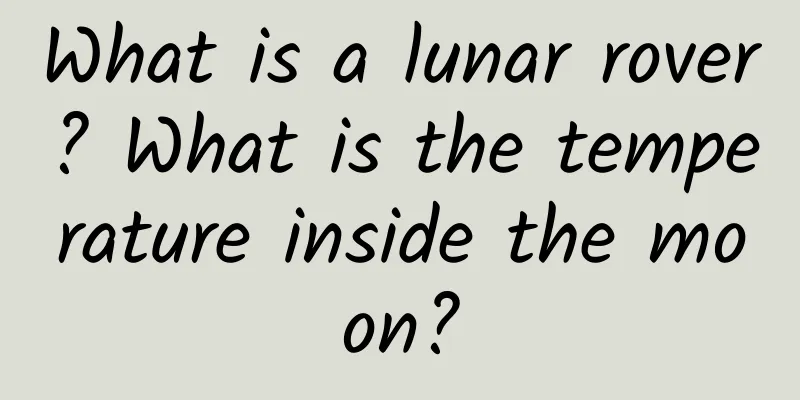What is a lunar rover? What is the temperature inside the moon?

|
The moon, commonly known as the moon, is also called the moon. In ancient China, it was also called Taiyin, Xuantu, Chanjuan, and Wangshu. It is the only natural satellite of the earth and the fifth largest satellite in the solar system. The moon is a spherical celestial body that revolves around the earth. It is also the only natural satellite of the earth. What is a lunar rover? What is the internal temperature of the moon? Are you particularly curious? Take a look now! Contents of this article 1. What is a lunar rover? 2. What is the internal temperature of the moon? 3. Is there life on the moon? 1What is a lunar rover?The lunar rover is a special vehicle that can travel on the lunar surface and complete complex tasks such as lunar exploration, investigation, collection and analysis of samples. In the laboratory, the scientific name of this important role is "lunar surface rover". In order to enable the lunar rover to travel smoothly on the lunar surface, the United States and the former Soviet Union launched a series of satellite explorations and conducted repeated scientific experiments on the lunar surface environment, laying a solid foundation for the success of carrying the lunar rover on the probe. Scientists analyze and study the valuable data brought back by the lunar rover's field investigation on the lunar surface, which greatly deepens mankind's understanding of the moon. Lunar rovers can be divided into unmanned lunar rovers and manned lunar rovers. Unmanned lunar rovers consist of a wheeled chassis and an instrument cabin, powered by solar cells and batteries. The world's first unmanned lunar rover was sent to the moon by the Luna 17 probe launched by the former Soviet Union on November 17, 1970. The rover chassis was made of aluminum alloy tubing and had a hinge in the middle to allow for storage. Each aluminum wheel had its own electric drive and mechanical brake. The tires were made of woven steel mesh wire coated with zinc. All of the rover vehicles were eventually left on the moon. 2What is the internal temperature of the moon?The internal temperature of the moon is as high as 1300 to 1900 degrees Celsius. With the help of lunar orbiters, scientists have obtained detailed gravity distribution results of the moon and found that the diameter of the moon has expanded and contracted by several centimeters due to changes in the earth's gravity. If the center of the moon is cooled and solidified, the expansion and contraction should be smaller. Based on the transmission speed of moonquake waves observed in the past, the internal structure and viscosity coefficient of the moon were inferred. The results showed that the viscosity coefficient of the lower part of the lunar mantle below about 1,300 kilometers is very low and very soft, which is why the observed expansion and contraction occurs. Due to the earth's gravity, this part of the lunar mantle can effectively generate heat. The expansion and contraction of the moon's diameter indicates that the moon has not yet cooled and solidified. As a result of the influence of the earth on the moon, the interior of the moon is still being heated. The research team speculates that the lower part of the lunar mantle should be in a molten state. 3Is there life on the moon?There is no life on the moon. Because the moon has no atmosphere, life cannot be born. The moon is a spherical celestial body that revolves around the earth. It is also the only natural satellite of the earth. In Chinese, it is commonly called the moon or the moon. In ancient times, it was also called Taiyin, Xuantu, Chanjuan, and Yupan. Lunar eclipse phenomenon: A lunar eclipse is a special astronomical phenomenon, which means that when the moon passes behind the earth's shadow, the sun's light is blocked by the earth. That is to say, the sun, the earth, and the moon are exactly (or almost) in the same straight line at this time, so the light from the sun to the moon will be blocked by the earth. From the perspective of the earth, when a lunar eclipse occurs, the directions of the sun and the moon will differ by 180°. It should be noted that since the orbits of the sun and the moon in the sky (called the ecliptic and the ecliptic) are not in the same plane, but have an intersection angle of about 5°, only when the sun and the moon are near the two intersection points of the ecliptic and the ecliptic respectively, can they have the opportunity to form a straight line and produce a lunar eclipse. |
<<: What is the shape of the bright part of the moon we see called? The origin of the moon
>>: What is the largest crater on the moon? Can you see a solar eclipse on the moon?
Recommend
How to choose medication during an acute migraine attack?
This is the 3213th article of Da Yi Xiao Hu In or...
What are the dangers of uterine curettage?
Nowadays, many young female friends often do not ...
I've been feeling nauseous and wanting to vomit recently and I'm worried that I'm pregnant, but I haven't bought any test strips yet. How can I check if I'm pregnant without using any test strips?
You can determine pregnancy without using a test ...
Highly contagious! A man said his wife got infected when she went to the toilet, and he developed a fever a few hours later!
Woman gets infected after using public toilet The...
Picture of amniotic fluid in four months of pregnancy
There are always some signs before a pregnant wom...
Can I eat tofu skin during menstruation?
Soybeans have a very long history in China. It al...
Postpartum lochia is clean and bleeding
Normally, after a woman gives birth, some blood-c...
Is Maiqiu'er's explanation of the residue reliable?
In response to the milk quality issue that has at...
What can you eat with cucumber to lose weight? One look and you'll know
Losing weight by using cucumbers is a method know...
What tests should be done at 16 weeks of pregnancy
The 16th week of pregnancy has entered the second...
Can Traditional Chinese Medicine treat uterine fibroids?
Uterine fibroids are a disease that middle-aged w...
Factors that cause two periods in one month
We all know that menstruation comes once a month....
When will the LV Onthego small size be released? How much does the LV Onthego small size cost?
The LV Onthego small size will be available in Ja...
What should a woman do if there is water and it smells bad in her belly button?
For girls, the belly button is also a tool to sho...
Early pregnancy gray marks mean you are just pregnant
If you want to know whether you are pregnant or n...









